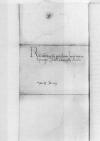Letter #1166
Sigismund I Jagiellon to Ioannes DANTISCUSVilnius, 1534-[06]-01
| received [1534]-06-12 Manuscript sources:
Auxiliary sources:
Prints:
| ||||||||||||||||||||
Text & apparatus & commentaryPlain textText & commentaryText & apparatus
Reveren(do) in Christo Patri, domino
Reveren(de) in Christo Pater sincere nobis dilecte.
Redditae sunt nobis cf.
Quae bene valeat.
Ad mandatum


 BNW, BOZ, 953, f. 119v
BNW, BOZ, 953, f. 119v